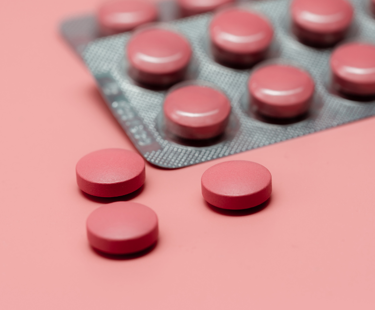Background and existing therapies
Nausea and vomiting in pregnancy, often known as ‘morning sickness’, is experienced by up to 80% of pregnant women. Morning sickness is typically experienced in the first trimester with symptoms clearing up about week 20 (or longer in some cases) of pregnancy. It is unpleasant and can impact quality of life. Some pregnant women may be sick many times a day and unable to keep food or drink down. In very severe cases (such as those with hyperemesis gravidarum) this can lead to hospitalisation and can even be life-threatening.
Existing remedies for morning sickness include dietary changes (such as avoiding foods with lots of sugar or saturated fats), lifestyle modifications (such as resting more), pharmaceutical and non-pharmaceutical interventions.
Common pharmaceutical interventions include: vitamin B6 (pyridoxine) (a first-line treatment for mild to moderate nausea and vomiting in pregnancy), doxylamine (an anti-histamine that is commonly used in combination with vitamin B6), ondansetron (a serotonin 5-HT3 receptor antagonist originally used for nausea associated with chemotherapy and surgery), metoclopramide (a dopamine receptor antagonist that has prescribed for nausea and vomiting, which works by enhancing gastric motility) and prochlorperazine (an antipsychotic that can be effective in treating severe nausea and vomiting in pregnancy).
Whilst the pharmaceutical interventions mentioned help to address the symptoms of morning sickness, there is no hard and fast treatment that works for everyone’s morning sickness.
The exact cause of morning sickness isn’t entirely known. Some have proposed that nausea and vomiting in pregnancy is caused by a mixture of physical and chemical changes in the body such as low blood sugar, increase in pregnancy hormones such as human chorionic gonadotropin (HCG) or estrogen, blood pressure fluctuations and changes in metabolism.
There is recent evidence to suggest that morning sickness is related to the production of the hormone Growth Differentiation Factor-15 (GDF-15) by the placenta, which acts on the mother’s brain to cause her to feel nauseous and vomit.
In a recent study, Fejzo et al1 found that the severity of nausea and vomiting in pregnancy is the result of the interaction of fetal derived GDF-15 and the mother’s sensitivity to this peptide, which is substantially determined by her prior exposure to the hormone. Fejzo et al suggested that blocking GDF-15 action in the pregnant mother could be a highly effective therapy for women suffering from nausea and vomiting in pregnancy, particularly those diagnosed with hyperemesis gravidarum.
These findings from Fejzo et al open new avenues and strategies for treatment and prevention of nausea and vomiting during pregnancy. For example, safely increasing circulating GDF-15 levels before pregnancy with, for example, recombinant GDF-15 may be a useful strategy in preventing nausea and vomiting during pregnancy. Metformin is also known to increase GDF-15 in humans and could be a potential prophylactic agent.
Repurposing drugs
Utilizing existing medications that either increase GDF-15 levels prior to pregnancy or block GDF-15 action during pregnancy offers a promising strategy for creating new treatments aimed at alleviating nausea and vomiting associated with pregnancy.
The practice of repurposing established drugs for new therapeutic uses is a well-recognized strategy within the pharmaceutical industry. This method capitalizes on the known safety profiles and pharmacological information of these medications, potentially leading to significant reductions in both the time and costs required to develop and market new treatments.
In recent years, drug repurposing has become increasingly significant, particularly in response to urgent health crises like the COVID-19 pandemic. During this time, existing medications were assessed for their potential efficacy against the virus. A notable example is tocilizumab, an anti-rheumatic medication that was repurposed to help reduce mortality rates among hospitalized COVID-19 patients.
The involvement of intellectual property (IP)
The success of drug repurposing initiatives is heavily influenced by intellectual property (IP) rights. Understanding the interplay between drug repurposing and IP rights is crucial for researchers, pharmaceutical companies, and policymakers aiming to maximize the benefits of this strategy while ensuring that innovations are adequately protected and incentivized.
Patent protection is an important consideration. It is possible to obtain new patents for novel uses of existing drugs in many jurisdictions. For example, at the European Patent Office, you can obtain a patent for a second or subsequent medical use of a known substance or composition.
Establishing a strong brand identity and trade mark protection for repurposed medicines is also vital for differentiating the product in the market, and for building recognition and trust amongst consumers.
Devising and implementing robust enforcement strategies to monitor and address potential intellectual property infringements is important for safeguarding your rights and preventing unauthorised uses.
Existing patents on the original drug can complicate the repurposing process by limiting your ability to develop or market the repurposed drug. Costly licence agreements may be required to continue with the development and commercialization of a repurposed drug. It is therefore crucial that you conduct an intellectual property landscape analysis to determine your freedom-to-operate. This can reduce your risk of unknowingly infringing existing patent rights and ultimately avoid costly litigation that can result from such infringement.
It is recommended that you consult with a intellectual property specialist early on to enhance the value and potential of your IP portfolio. Their expertise will also help you address freedom-to-operate risks effectively.
At Secerna LLP, we have a proven track record of securing robust patent protection and trademark registration worldwide across a diverse range of technologies. Our expertly crafted IP filings comprehensively encapsulate complex inventions and brand identities while maximizing the scope of protection based on existing knowledge. Additionally, our freedom to operate expertise ensures that your business can navigate the competitive landscape with confidence, mitigating risks associated with intellectual property infringement. By safeguarding your intellectual assets, we empower your business to achieve its full potential.
If you would like further information regarding your IP portfolio, please contact us today at docketing@secerna.com.
1M. Fejzo et al Nature 2024, 625, 760-767

